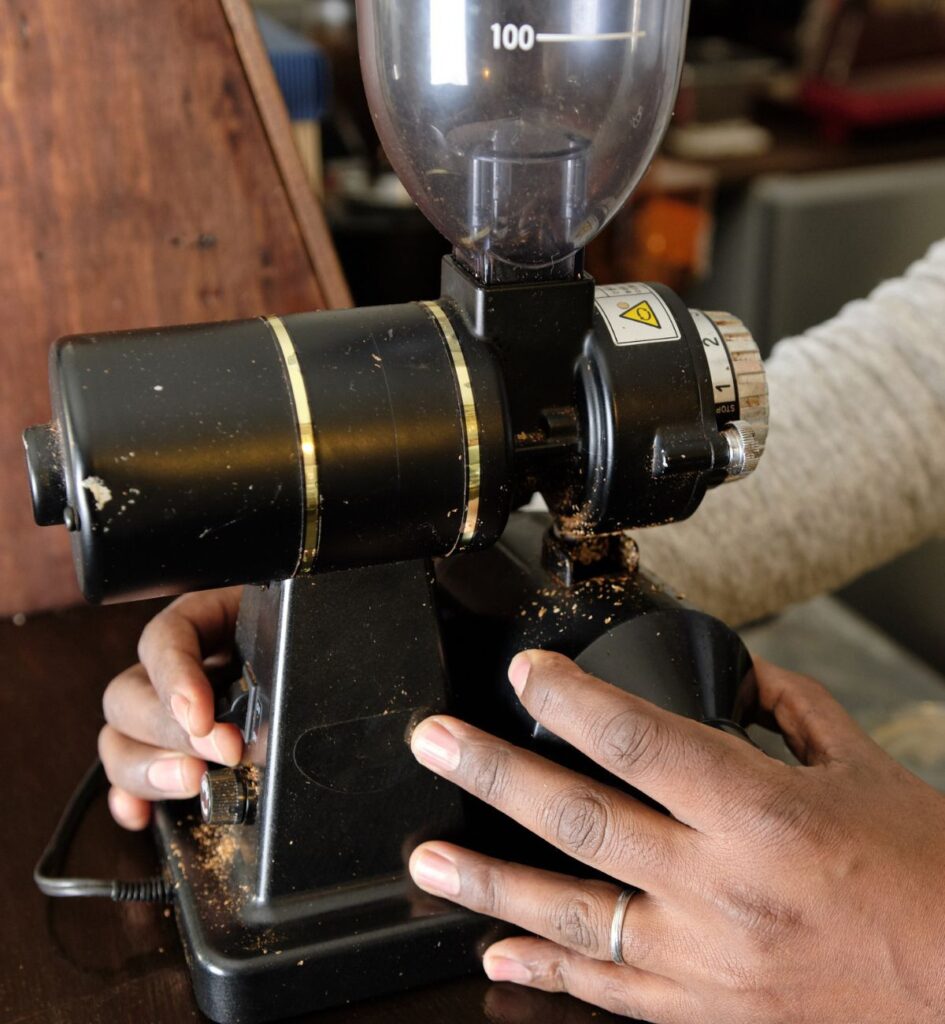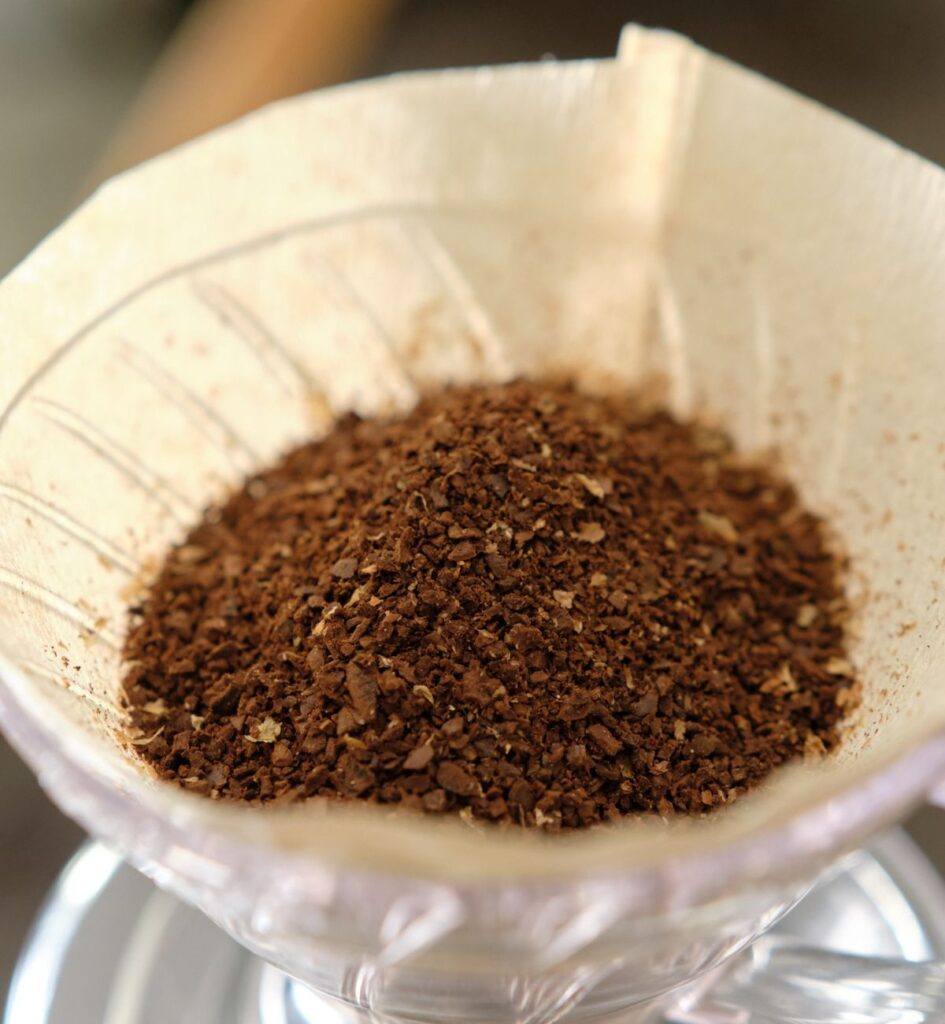How to grind coffee beans. Are you tired of mediocre coffee? Do you want to create a delicious, flavorful brew in the comfort of your own home? Look no further. In this section, we will guide you through the essential techniques and methods of grinding coffee beans at home. You’ll learn the best practices and tips to achieve the perfect grind, ensuring a delicious cup of coffee every time.
Grinding coffee beans at home may seem intimidating, but with the right techniques and equipment, it’s easier than you think. The superiority of freshly ground coffee extends beyond its exquisite taste; it grants you the freedom to delve into diverse grind sizes and brewing methods, allowing you to customize the flavor according to your unique palate. With our comprehensive manual and expert guidance, you’ll effortlessly acquire the skills to grind coffee beans like a true fan.
Are you ready to take your coffee game to the next level? Keep reading to discover the best way to grind coffee beans, essential coffee grinder tips, and much more.
Understanding Coffee Grinding Techniques

Before you can start grinding coffee beans at home, it’s important to understand the different techniques available. There are two primary grinding methods: manual and electric.
1. Manual Coffee Grinding Techniques
Manual coffee grinders are inexpensive and allow greater control over the grind size. They are portable, making them ideal for travelers or outdoor enthusiasts who enjoy a freshly brewed cup of coffee on the go. However, manual grinders require physical effort and can be time-consuming.
Tip: To achieve the best results with a manual grinder, ensure the burrs are properly aligned and the grind size is consistent.
2. Electric Coffee Grinder Usage
Electric coffee grinders offer convenience and speed, making them popular for home brewing. They are available in blade and burr varieties, with burr grinders being the preferred option for achieving a consistent grind size. Electric grinders offer a wide range of settings, allowing you to adjust the grind size to suit your preferred brewing method.
Tip: For the best results with an electric grinder, ensure the grinds chamber and burrs are clean before use.
Choosing the correct coffee grinding technique depends on your preference and brewing needs. Manual grinders are perfect for those who enjoy a slower, more tactile approach to brewing, while electric grinders are ideal for those who prefer speed and convenience.
Selecting the Right Coffee Grinder

When grinding coffee beans, selecting the right grinder is paramount to achieving the perfect grind. There are two main types of coffee grinders: blade and burr grinders.
1. Blade Grinders:
A blade grinder uses a spinning blade to crush the beans, similar to a blender. As a result, the grind could be more consistent, with some beans being ground finely while others remain coarse. Blade grinders are generally less expensive than burr grinders but may not provide the desired consistency for certain brewing methods.
2. Burr Grinders:
Utilizing a pair of abrasive surfaces, a burr grinder crushes the beans to create a uniform grind size that suits various brewing methods exceptionally well. There are two distinct variations of burr grinders available: conical and flat. Although conical burr grinders generally carry a higher price tag, they offer unparalleled precision and control over the desired grind size. Conversely, flat burr grinders are more cost-effective but tend to generate more heat during operation, potentially influencing the coffee’s flavor profile.
To choose the right grinder, consider your brewing method, budget, and personal preferences. A high-end conical burr grinder may be the best choice if you’re an espresso fan. If you prefer pour-over or French press, a mid-range burr grinder may suffice.
"Investing in a quality grinder may seem expensive upfront, but it will pay off in the long run with a more consistent and flavorful cup of coffee."
Which grinder is the right fit for you? Check out our coffee bean grinding tutorial for more detailed information and tips on choosing the best coffee grinder.
Adjusting Grind Size for Desired Brew
The flavor and strength of your coffee depend heavily on the grind size you use. Selecting the right grind size for your specific brewing method is essential to achieve the perfect taste. This section will provide instructions on adjusting the grind size based on your brewing method.
First, let’s review the basic coffee grinding techniques and methods:
- Burr Grinders: These grinders produce a consistent, uniform grind and are preferred for their precision. They are available in both manual and electric versions.
- Blade Grinders: These grinders use a spinning blade to chop the beans, resulting in an uneven, inconsistent grind. While they are more affordable, blade grinders are not recommended for achieving a high-quality grind.
- Manual Grinders: These grinders rely on your strength to manually turn the crank and grind the beans. They are quieter than electric grinders and are a good option for those on a budget or for travel purposes.
- Electric Grinders: These grinders use electricity to power the grinding process and are the most common type of grinder. They come in both blade and burr versions and offer convenience and speed.
Now, let’s take a look at the ideal grind sizes for some popular brewing methods:
| Brewing Method | Ideal Grind Size |
| Pour-Over | Medium-Fine |
| French Press | Coarse |
| Espresso | Very Fine |
Remember that these are general guidelines; you may need to adjust the grind size based on your taste preferences. Experimenting with different grind sizes is recommended to find the perfect brew for you.
Adjusting Your Burr Grinder
Using a burr grinder will give you more control over the grind size. Most burr grinders have a dial or knob to adjust the setting to your desired size. To adjust the grind size:
- Refer to your grinder’s manual to identify the adjustment method.
- Turn the dial or knob to adjust the grind size. Clockwise typically results in a finer grind, while counterclockwise results in a coarser grind.
- Grind a small amount of coffee and test the size to ensure it matches your desired size.
- Make additional adjustments as needed until you achieve your desired grind size.
Adjusting Your Blade Grinder
Blade grinders do not offer the same control over the grind size as burr grinders. However, you can still adjust the grind size to some extent:
- Measure your desired amount of coffee beans.
- Grind the beans in short bursts, shaking the grinder in between to achieve a more uniform grind.
- Check the grind size and make adjustments as needed using the same process.
By adjusting the grind size based on your brewing method, you’ll be able to achieve a flavorful, high-quality cup of coffee every time.
Grinding Beans: Step-by-Step Guide

You’ve selected the perfect coffee grinder, and it’s time to start grinding beans. Follow these simple steps for a consistent and flavorful grind every time.
Step 1: Measure the Beans
Before you begin, measure the desired amount of beans using a kitchen scale or scoop. Aim for a ratio of two tablespoons of coffee beans per six ounces of water for a standard strength brew.
Step 2: Choose the Grind Size
Select the appropriate grind size based on your brewing method. For pour-over or drip coffee, use a medium to fine-grind. For the French press, use a coarse grind. For espresso, use a fine grind.
Step 3: Adjust the Grinder
Set the grinder to the desired grind size. With burr grinders, adjust the distance between the burrs, while blade grinders require adjustments to the grinding time. Refer to the instruction manual for specific adjustment details.
Step 4: Grind the Beans
Place the coffee beans into the grinder and begin grinding. Hold the lid securely and avoid overfilling the machine, or the grinder may become clogged.
Step 5: Check the Grind
After grinding, check the consistency of the grind. It should be uniform and free of large chunks or fine powder. Adjust the grinder as needed and repeat the process until the desired grind is achieved.
Step 6: Store the Grind
Once you’ve achieved the perfect grind, store it in an airtight container in a cool, dry place until ready for use. Avoid storing the coffee in the grinder for extended periods as it can lead to stale or unevenly ground coffee.
Tip: Clean the grinder after each use to remove leftover coffee grounds and prevent cross-contamination of flavors.
With these simple steps, you can confidently grind coffee beans at home using your preferred brewing method. Remember to experiment with different grind sizes to find the perfect flavor profile for your taste buds.
Storing and Preserving Freshly Ground Coffee

Coffee lovers know the best way to enjoy a flavorful brew is to grind coffee beans. However, once you’ve mastered the art of grinding coffee beans, you must know how to store and preserve their freshness to reap the benefits of your hard work. Proper storage is essential for maintaining the taste and aroma of your freshly ground coffee, ensuring that the brewing process produces a perfect cup every time.
The Best Storage Containers for Freshly Ground Coffee
Choosing the right storage container for your freshly ground coffee is crucial. You need to select an airtight container that doesn’t allow the coffee to come into contact with moisture or air, which can degrade the quality of the beans. A common mistake is storing coffee beans in the original bag, which is often not airtight and allows air and light to get in. Instead, opt for a storage container with an airtight seal and an opaque or colored exterior that shields the beans from light and heat.
You can use glass, ceramic, or stainless steel containers for storing your coffee beans. Glass and ceramic containers are great options, as they are non-reactive and won’t affect the flavor or aroma of the coffee. Stainless steel containers are also good choices, but ensure they have airtight seals to prevent air and moisture. Avoid plastic containers, which impart unwanted flavors and aromas to your coffee.
How to Store Freshly Ground Coffee
Once you’ve selected the right storage container, you must properly store your ground coffee. Store your coffee in a cool, dark place, away from direct sunlight, heat, and moisture. Cupboards or pantry shelves are great storage options, but ensure the container is far from the oven, stove, or heat-emitting appliances. The optimal storage temperature for coffee is between 60 and 75°F.
It’s also essential to store only the coffee you’ll use within a week. Ground coffee loses freshness quickly and can start to go stale after a few days, depending on the storage conditions. To prevent staleness, grind only the coffee you need for your immediate brewing needs. Avoid storing coffee in the freezer or refrigerator, as it can cause moisture to develop on the coffee beans and affect the taste and aroma.
The Importance of Freshly Ground Coffee
Grinding coffee at home offers several advantages over using pre-ground coffee:
- Freshly ground coffee is more flavorful and aromatic, as the essential oils and compounds in the coffee beans are preserved when you grind them just before brewing.
- Grinding your coffee beans gives you more control over the grind size, enabling you to adjust it to your desired brewing method and recipe.
- Freshly ground coffee provides a superior taste experience, making it the preferred choice of coffee enthusiasts.
Conclusion
Properly storing fresh ground coffee is essential for preserving its freshness and flavor. Choose an airtight, opaque storage container for your coffee and keep it in a cool, dark place away from heat and moisture. Remember to grind only the coffee you need immediately, and avoid storing coffee in the freezer or refrigerator. With these storage tips, you can enjoy a perfectly brewed cup of coffee every time!
Troubleshooting Common Grinding Issues
Despite your best efforts, there may be times when you encounter some common issues when grinding coffee beans. However, with a few tips and tricks, you can overcome most of these problems and maintain the quality of your grind. Below are some common issues and their troubleshooting methods:
1. Uneven Grind
If your coffee grounds are not uniform in size, it could be due to blade grinders or burr grinders that need cleaning. For blade grinders, use a brush or dry towel to clean the blades, which can become dull with time. For burr grinders, disassemble the grinder and clean the burrs with a brush or cloth. Clean the grinder thoroughly before each use to ensure a consistent brew.
2. Excessive Heat During Grinding
Excessive heat can transfer to ground coffee and cause a stale or burned flavor. To avoid this, use a grinder that has less heat transfer, such as a burr grinder. Additionally, avoid grinding a large amount of coffee beans at once, which can cause the grinder to overheat. Instead, grind smaller batches of beans and allow the grinder to cool between use.
3. Preventing Grinder Clogs
Grinder clogs can cause uneven grind and can be frustrating to deal with. To prevent clogs:
- Ensure that your coffee beans are not too oily, as oily beans can stick to the grinder’s blades or burrs.
- Avoid grinding too fine, which can cause the grinder to clog.
- If clogs occur, disassemble the grinder and clean it thoroughly before using it again.
By following these tips, you can troubleshoot common grinding issues and maintain the quality of your grind. Keep in mind that regular cleaning and maintenance are crucial for the optimal performance of your coffee grinder.
Cleaning and Maintaining Your Coffee Grinder
Now that you’ve invested in a quality coffee grinder, it’s important to properly clean and maintain it to ensure optimal performance and longevity. Neglecting to clean your grinder can lead to stale coffee, inconsistent grind quality, and even damage to the machinery. Here are some essential coffee grinder tips for cleaning and maintaining your equipment:
Step 1: Unplug and Disassemble Your Grinder
The first step in cleaning your grinder is to unplug it from the power source and disassemble it. Remove the hopper, grind chamber, and any removable parts, such as the burrs or blades.
Step 2: Brush Away Loose Grinds
Using a soft-bristled brush, gently brush away any loose coffee grounds from the hopper, grind chamber, and removable parts. Make sure to remove any debris that may be stuck in the crevices or corners.
Step 3: Clean Removable Parts
If you’re using a burr grinder, remove the burrs and use a soft brush to clean them. You can also use a small amount of detergent and warm water to clean the parts gently. Be sure to rinse and dry thoroughly before reassembling.
Step 4: Wipe Down Exterior Parts
Take a damp cloth and carefully clean the outer parts of the grinder, including the hopper lid, machine body, and any exposed areas. Be cautious not to use aggressive chemicals or abrasive cleaning agents, as they could cause damage to the grinder’s finish.
Step 5: Grind Rice or Bread
One effective way to remove residual coffee oils or flavors from the grinder is to grind a small amount of uncooked rice or bread. This will help absorb any oils or trapped coffee grounds that may have accumulated in the machinery.
Step 6: Regular Maintenance
Regular maintenance is key to keeping your coffee grinder in top shape. Depending on how often you use your grinder, you may need to take it apart and clean it every few weeks. Also, refer to the manufacturer’s instructions for additional maintenance suggestions or cleaning tips.
By following these coffee grinder tips, you’ll be able to maintain the quality of your equipment and ensure a fresh and flavorful cup of coffee every time.
Expanding Your Coffee Grinding Skills
As you become more confident in your coffee-grinding abilities, it’s time to explore new and exciting techniques. Different brewing methods require specific grind sizes, so experimenting with various methods will allow you to perfect your skills and broaden your coffee knowledge.
Cold Brew
Cold brew is a method where coffee grounds are steeped in cold water for an extended period, usually overnight. The outcome is a smooth and refreshing coffee concentrate that can be chilled or with milk. It’s important to use a coarser grind resembling raw sugar or sea salt to achieve the perfect cold brew. This helps prevent excessive extraction and any unpleasant bitterness.
Turkish Coffee
Turkish coffee is a traditional method of brewing coffee that involves finely ground beans and a special pot called a cezve. Aim for a texture similar to powdered sugar to achieve the correct grind size. Turkish coffee is typically brewed with sugar and boiled on the stovetop. The result is a strong and flavorful coffee with a unique foam layer.
AeroPress
The AeroPress, a beloved technique for brewing coffee, harnesses the power of air pressure to extract the rich flavors of coffee. It offers a convenient and hassle-free option for those seeking a swift cup of joe with little mess to clean up afterward. To achieve the ideal combination of taste and potency, it is recommended to use a grind size that falls between fine and medium-fine, akin to the texture of table salt. By exploring various grind sizes and brewing methods, one can refine one’s palate and ascend to the status of a genuine coffee lover.


